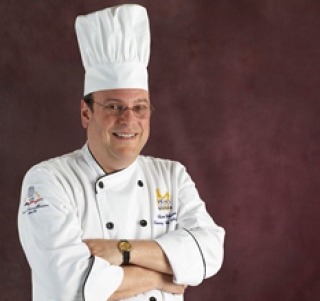
Fifty-Minute Classroom: Cooking by Description
27 April 2016Chef Adam Weiner challenges classes by instructing students to cook a certain food with no recipe and sometimes the wrong equipment required for execution. His response to the challenge: “Get it done.”
By Chef Adam Weiner, CFSE
During the last several months, I have begun a discussion on how to teach your students the social issues of sustainability and local/farm-to-fork movement. I will continue this line of topics with an article about low carbon footprint in the June edition of Gold Medal Classroom.
But, this month I want to go in a different direction. Many of your students are getting ready to graduate. So, it is time to test them in a unique way: cooking by description.
In January 2013 this column was titled Do You Teach Recipes or Techniques? I followed that up a month later with Reading and Writing Recipes. As you know from these two articles I believe students, whether they are going to cook at home or in the most professional kitchen on earth, need to know how to read, write, follow a recipe, and cook by their knowledge of basic cooking techniques.
I also think students, from home cooks to professionals, also need to know how to cook by description. This is a hybrid of recipes and techniques where the student is told what the dish is, and then has to prepare it. In other words, you give the student a name and brief description of the dish and they have to create it without a recipe and without seeing you demonstrate it.
I start the students off easily. I give them a written definition of the dish. (My two favorite sources for this are THE FOOD LOVER’S COMPANION and WIKIPEDIA.) I then give them a presentation time and let them go. If you like, you can also give your students pictures of the dish, but to be candid I think that is cheating.
After your students become fairly proficient at this, you kick it up a notch. Instead of giving them a written definition, you give it to them orally. The first time you do this, you repeat it a couple of times. After they have done it a few times you give them a warning that you are only going to give the description once and stick to that. This is good practice for them if they are going to work in a commercial kitchen.
Don’t select a dish that is very well known to them. Reading the description of a hamburger is not going to teach them anything. Here are some ideas that I have used recently in my class. Because of regional food differences, some of these might be too common in your area, and thus you shouldn’t use them in your class:
- Joe’s Special
- Spam Musubi
- Reuben Sandwiches
- Chop Suey
- Gumbo
- Etouffee
- Risotto
- Rhode Island Clam Chowder
- Potatoes Au Gratin
- Couscous
- Ratatouille
- Loco Moco
- Fruit Compote or Coulis
- Welsh Rabbit (Welsh Rarebit)
- Quick Pickles
While we are on the subject of challenging your students before they finish your class, let me take the liberty of giving you one more idea: Set up cooking days where your students are not allowed to ask you any questions.
Give them the assignment and tell them, “Get it done.” After doing this a few times, kick it up a notch by giving them an assignment when they don’t have either the equipment or the ingredients (or both) to complete it the way they want. For example, I will remove all of baking sheets and then tell students to make cookies. I will hide all the green peppers and then give them a description of a dish that calls for green peppers. When students come to me and say, “Where are the baking sheets?” or “We are out of green peppers,” I tell them calmly, “Get it done.” This is a lesson in team work and problem solving. This is also a great practice for real life. Students need to learn how to function in the kitchen (and in life in general) by learning how to work with what they have.
Former Secretary of Defense Donald Rumsfeld said, “You go to war with the army you have and not the army you wish you had.” My philosophy is this: “You cook with the equipment and ingredients you have and not the ones you wish you had.” The most important part of this exercise is that you do not say anything to the students unless a matter of safety is involved. If raw chicken is being placed on lettuce you have to intervene. If black smoke is billowing out of a pan and the student is about to pour water on it then you need to step in. Hopefully, by the end of the school year, those basic mistakes should not be happening. Again, only intervene if it is a safety issue.
So, here is my final suggestion for the last weeks of school. Combine both of these ideas. Give your students a description of a dish, and then have them prepare it without you getting involved and without them having all of the ingredients or all of the equipment.
Chef Adam Weiner, CFSE, teaches a 20-week Introduction to Cooking program for JobTrain on the San Francisco Peninsula, and is a frequent presenter at CAFÉ events throughout the nation.
